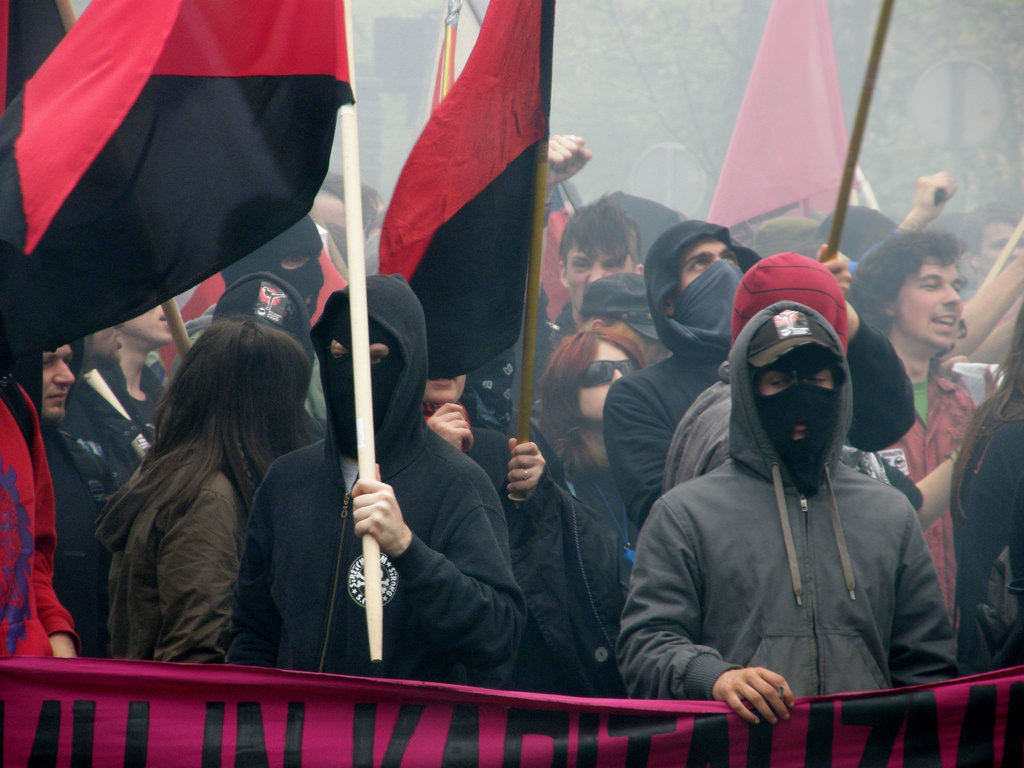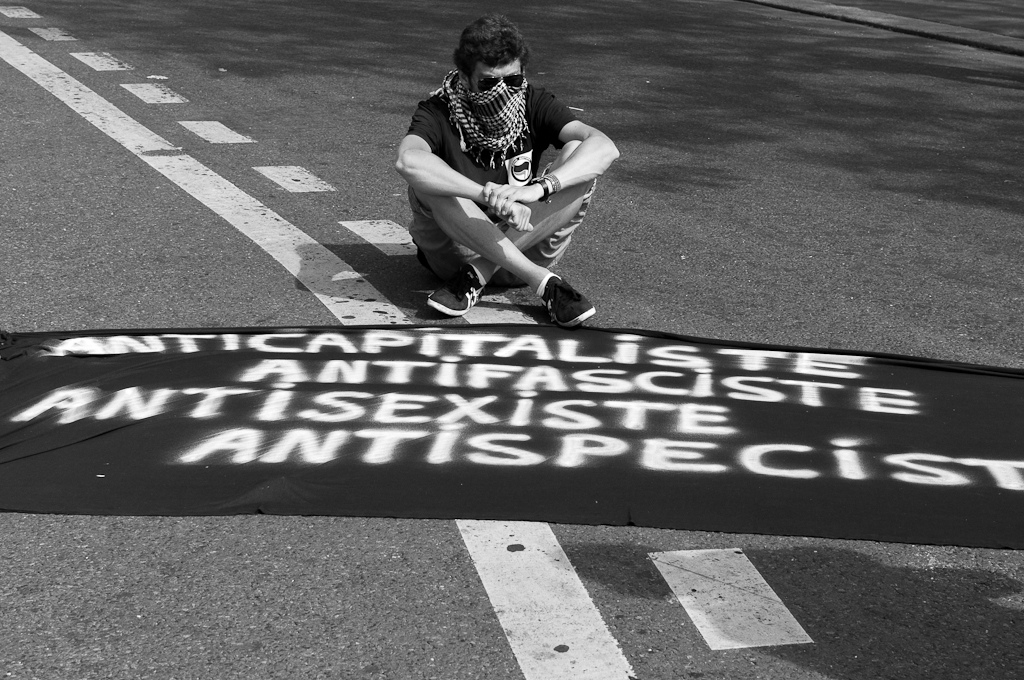Last month, counterprotesters dressed mostly in black gathered in Charlottesville to confront the alt-right. They covered their heads with helmets and hats and hid their faces behind an assortment of dark sunglasses and bandanas — with only a strip of skin showing around their eyes. Some members of the group repped T-shirts with anti-fascist slogans and symbols on them, others opted for plain black hoodies. Since then, similar raven uniforms have been spotted around the country at locations where the far-right and left clash. These black-clad dissenters have come to be known as antifa.
Before the alt-right met in Charlottesville they called on their members to wear a uniform in an effort to look “appealing” and cohesive. The mass of white supremacists showed up in a range of khakis, polos, and “Make America Great Again” hats. Their opposition, the anti-fascists, weren’t concerned about cohesive outfit choices — unless it was for a tactical reason.
As Mark Bray, author of Antifa: The Anti-Fascist Handbook, explained to me there is no antifa uniform because it is not an organization, but a range of autonomous groups who are fighting racism around the world.
Although the American antifa movement gained more visibility post-Charlottesville, its roots go back to the 1920s when activists began protesting the fascism that was spreading across Europe at the time.
As Bray points out in his book, some individual antifa groups have adopted a common aesthetic. The Schwarze Scharen (Black Flocks), an antifa militia formed in Germany in 1929, would outfit themselves in all black with matching black berets. The Red Warriors, a radical group of antifa punks formed in France in the 1980s, would wear their bomber jackets inside out. But today most people who identify as antifa just put on their everyday clothing when fighting fascists, not riot gear.
“Normally I just wear regular clothes,” Daryle Lamont Jenkins, founder of the antifa organization One People’s Project and self-appointed spokesperson of antifa said over email. “If anything I wear something practical, like boots and jeans, things that can stand a little wear and tear.”

Understandably, practicality seems to be the overarching influence on the way antifa get dressed for a protest. As Jenkins explained, “I try to be prepared in case there is some sort of throwdown. I don’t want to wear the ‘Sunday’s best,’ so to speak.” This often means wearing things like a bandana or face mask in case there is tear gas or tight-fitting clothing so that they can’t be grabbed.
“[What people wear] certainly depends on what the goal is, whether it is to represent the politics or carry out a specific action that might need anonymity,” explained Bray. “I spoke to British anti-fascists from the 80s and 90s who preferred to dress in ‘casuals,’ which means as one anti-fascist put it, the police couldn’t tell the difference if they were fascist or anti-fascist. That was a bomber jacket and Doc Martens kind of look. There are all sorts of variations.”
Often when the media depicts antifa groups dressed in all black, it is because they are using a tactic called “black bloc.” Inspired by anarchists, this strategy was adopted by a German antifa group in the 1970s that would dress in all black, often sporting face coverings like motorcycle helmets or balaclavas. This uniform is meant to create anonymity for those antifa who were prepared to carry out militant action against fascists. But not everyone at a protest who is wearing black and covering their face is automatically antifa, as Bray noted. There are plenty of people who dress like that who aren’t associated with a group.
“The media tends to write about antifascists and the black bloc as specific groups,” explained Bray. “It is difficult for them to understand anti-fascism as a kind of politics or activity and the black bloc as a tactic. There is overlap, but not all anti-fascists do black bloc and not all black blocs are used for anti-fascist purposes.”
When it’s not strategic, the common all-black look associated with antifa is mostly a result of the fact that many people who are antifa come from the punk and metal scene, so the majority of their wardrobe is already black. “It carries a certain image, a revolutionary rejection of the status quo. So, I think that is the gist of it,” explained Bray, who pointed out that it is also the color of anarchism.
Still, people around the world do their own take on these tactics, like the pastel bloc, which calls on antifa groups to dress in rainbow colors. Antifa activists in Europe often co-opt the Palestinian keffiyeh scarf, which came to prominence outside of Palestine as a catchall symbol of solidarity with minorities.

Even designers have co-opted elements of this revolutionary aesthetic. Raf Simons presented a spring/summer 02 runway show full of models in balaclavas and hoodies armed with flares for a collection that represented rebellious militant youth. Most recently, Robert Geller presented a protest-themed fall/winter 17 collection that featured bomber jackets and colorful face masks.
One common theme of antifa wear around the country is the symbols like the three arrows of the Iron Front. The design is a circle with three down-facing arrows inside of it that was designed by an anti-Nazi paramilitary organization in the 1930s to easily cover a swastika. There is also the logo of two waving flags of the Antifaschistische Aktion.
“The flag logo comes out of Germany and is maybe the most influential symbol,” said Bray. “It can be adapted to different kinds of politics and groups whether you have a red flag and a black flag or two black flags, or a purple and black or pink and black flag, as a sort of feminist or queer anti-fascism.” These symbols have been printed on all types of merch from shirts to hoodies that can be bought on sites like Antifa Wear and Etsy. Some local antifa divisions even design and sell their own tees, but wearing antifa gear can easily make someone a target, which is why some protesters choose plain clothing instead.
“Normally, I don’t wear anything descriptive, but when I do, it will be some sort of a pin or T-Shirt conveying a message,” said Jenkins. “However, I would want someone to come up and ask me what I’m about rather than knowing before they even start speaking to me.”
In the same way that it’s important not to get distracted by the alt-right’s khakis and polos, we should look at what the anti-fascists are fighting against and not merely at what they’re wearing. Because they are clad in masks and hoodies, it is easy for Trump and others to perpetuate the belief that there is “violence on both sides,” but their goal is ultimately to fight hate.


